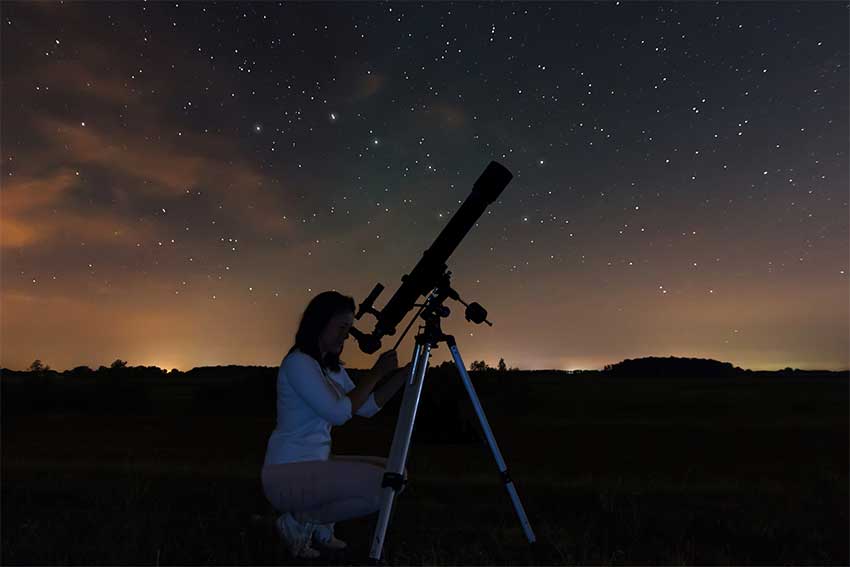Stargazing tips
Everyone can enjoy astronomy just by stepping outside on a clear night. With these tips, you will be able to make the most of the night sky and start your own exploration of the universe.
Tips
-
Move away from city lights
Cities are filled with light pollution caused by streetlamps, buildings and cars that drown out dimmer stars and planets in the sky.
-
Find a clear spot where you can see as close to the horizon as possible
Make sure tall buildings and trees are not blocking your view as you stargaze. Getting higher up on mountain tops can give you a great vantage point.

For an extra special treat, head out to one of these amazing stargazing locations across Canada. Some of them are among the Canadian sites with dark sky designations, which have been carefully protected from light pollution and offer an especially gorgeous view of the night sky.
-
Check the weather forecast
Nothing ruins a night of stargazing like the sudden appearance of clouds. Also make sure to dress for the weather: nights can get chilly all year round!
-
Get in touch with your nearest astronomy club
Other amateur astronomers are a fantastic resource in your quest to discover the universe. They can give you telescope recommendations, teach you how to spot constellations and share their passion for space with you. Visit the Astronomy North, the Royal Astronomical Society of Canada and the Fédération des astronomes amateurs du Québec (French only) websites to find the nearest astronomy club.
Tools you can use

Using a telescope will allow you to take a closer look at distant objects in the sky such as planets, galaxies and nebulae.
-
Your eyes
Many of the night sky's beautiful sights, such as constellations and the Milky Way, can be enjoyed with the naked eye. Sky maps and star finders can help guide you by pointing out the location of celestial objects. You can also use apps to turn your smartphone into an interactive star finder!
Avoid looking at bright lights while you're stargazing. This will make your eyes less sensitive. It is important to give your eyes 15 to 20 minutes to adjust to the darkness. Using red flashlights to get around is best for your eyes.
-
Binoculars and telescopes
Did you know that you can observe the Moon's craters with regular binoculars? A telescope is best for objects like planets, galaxies, and nebulae. There are many different kinds of telescopes at different price points. You'll find lots of guides online to pick the best telescope for you.
What to observe

Objects you can observe in the night sky include constellations, stars, planets and the Milky Way. (Credit: NASA)
-
Stars
The night sky is filled with bright dots, most of which are stars. They can vary in colour and brightness. Stars appear to twinkle because Earth's atmosphere is in motion and jostles the light emitted by stars.
One star can only be observed during the day: the Sun. Be careful: you should never look directly at it! Special telescopes or glasses are needed to look at the Sun without damaging your eyes.
-
Shooting stars
If you are lucky, you might spot a shooting star in the night sky! These are small grains of cosmic dust that burn up in our atmosphere. You could spot one at any time, but they are especially abundant during meteor showers.
-
Constellations
These groups of stars have been given names based on their shapes. Some recognizable constellations include Orion (and his famous belt) and the Big Dipper.
-
Planets
Some of the bright dots in the sky are actually planets, and one neat way to tell them apart from stars is to see if they're twinkling! Planets do not twinkle in the sky.
-
The Milky Way
If you are in a dark location, you might see a whitish hazy lane streaking across the sky. This is the disk of our galaxy, the Milky Way! The summer months are the best time of the year to observe the Milky Way from the northern hemisphere.
-
The Moon
You can observe its different phases throughout the lunar cycle, which lasts about 27 days. The Moon rises and sets at different times throughout the year, so be sure to check when to observe the Moon from your location!
Special sights

An outburst of shooting stars during the 2009 Perseid meteor shower. (Credit : NASA/JPL)
-
Meteor showers
A few times a year, Canadians are treated to some especially spectacular meteor showers. During the peak of those showers, dozens of shooting stars per hour can be seen streaking across the night sky.
The best meteor shower peaks are:
- the Quadrantids, in early January
- the Perseids, in mid-August
- the Geminids, in mid-December
-
Lunar and solar eclipses
Eclipses are some of the most magnificent celestial shows the universe has to offer. A lunar eclipse occurs when Earth casts a shadow on the Moon, while a solar eclipse happens when the Moon blocks out the Sun. Eclipses can be partial or total. To find out when the next eclipse visible from where you live will be taking place, consult an eclipse calendar.
-
The northern lights
The aurora are mainly visible in northern Canada, but do occasionally appear in southern skies during periods of intense solar activity. Follow the Canadian Space Agency's AuroraMAX pages on Facebook and Twitter to receive alerts to see the northern lights near you.
Explore further
- Date modified:
